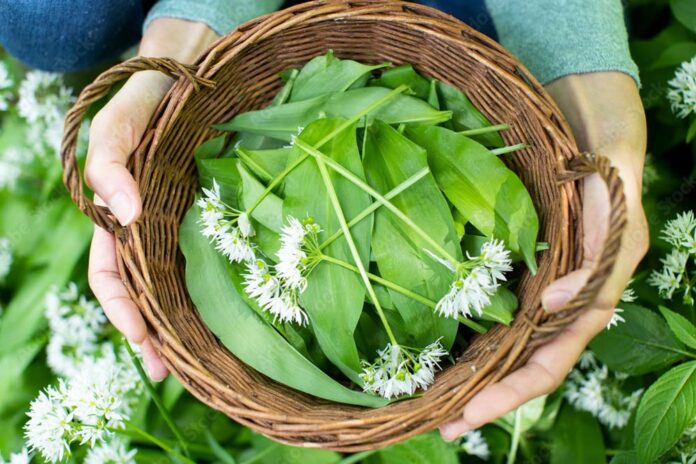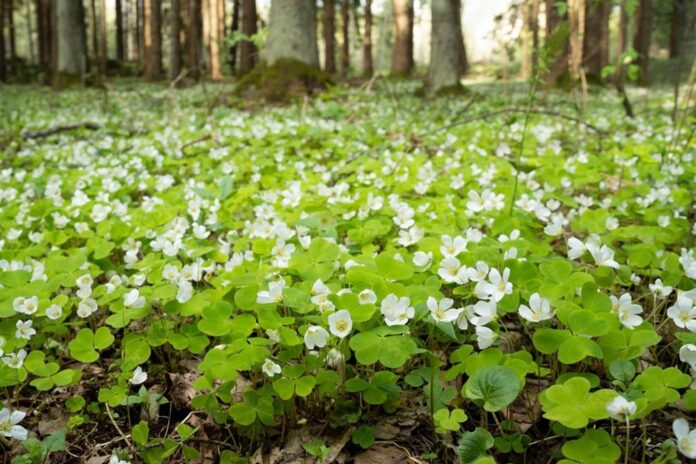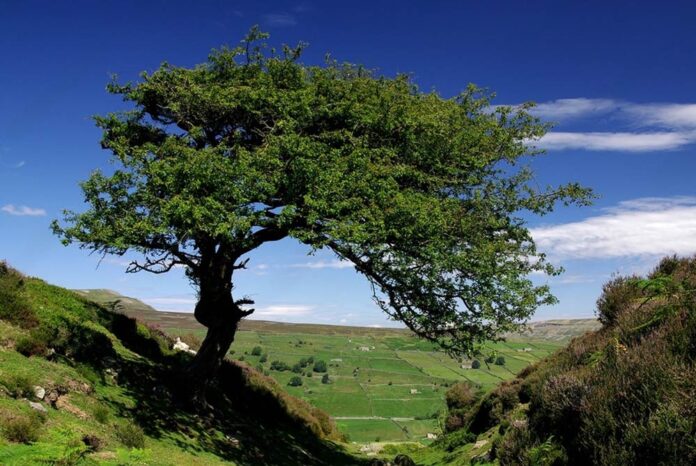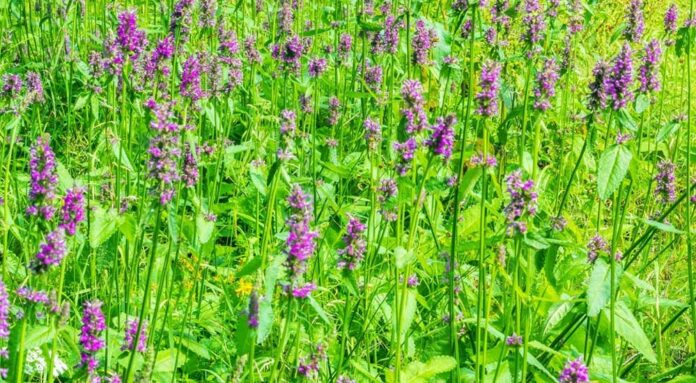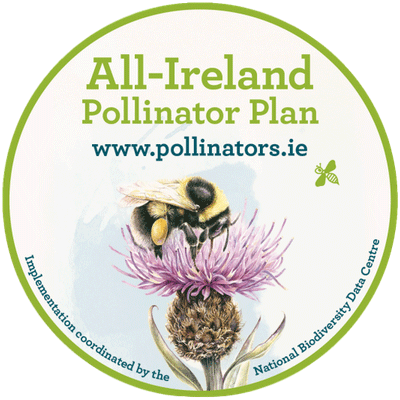Garlic Mustard: A Flavourful Spring Discovery
Garlic mustard (Alliaria petiolata) might be a familiar sight along your favourite hiking trails. This springtime wildflower, with its heart-shaped leaves and clusters of white flowers, offers a surprising potential – it can be a delicious and nutritious addition to your meals! Garlic mustard is also known by its Irish name Bóchoinneal.
Identifying Garlic mustard
Garlic mustard (Alliaria petiolata) might be a common sight on your hikes, but before you add it to your foraging basket, it’s crucial to identify it correctly. Look for these key characteristics to ensure you’ve got the right plant:
- Leaves: The most distinctive feature is the heart-shaped or triangular leaves with scalloped edges. When crushed, they release a strong garlic odour, earning the plant its name.
- Stems: Erect and hollow, with a smooth texture. These stems are typically green, but can sometimes have a reddish tinge near the base.
- Flowers: Keep an eye out for small, white, four-petaled flowers arranged in clusters at the top of the stem. These typically bloom in late spring or early summer.
- Habitat: Garlic mustard thrives in moist and disturbed areas. Look for it along trails, woodlands, and stream banks.
Remember: Other wild plants can resemble garlic mustard. Here are some additional tips for confident identification:
- The Root System: Garlic mustard has a long, white taproot. If you’re unsure about the plant, carefully unearth a small section of the root to confirm its appearance.
- The Smell Test: This is the most reliable way to identify garlic mustard. Crush a leaf between your fingers and take a whiff. The distinct garlicky odour is a clear giveaway.
- When in Doubt, Leave it Out: If you’re unsure about a plant’s identification, it’s always best to err on the side of caution and leave it where it is. There are plenty of resources available online and in-field guides to help you become more confident in your foraging skills.
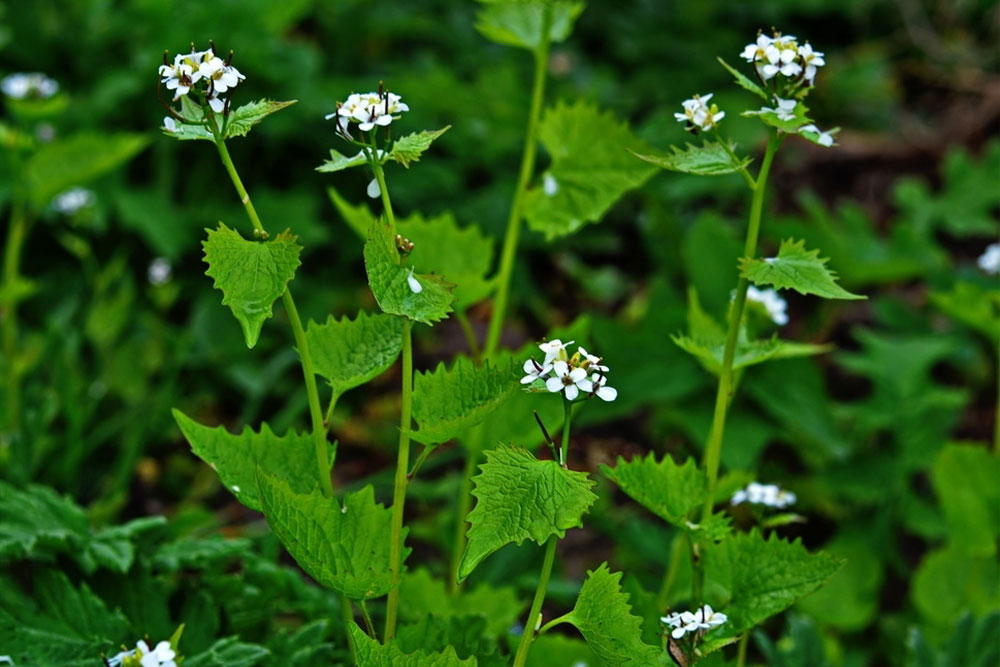
Pick the Season: The Prime Time for Garlic Mustard
The key to enjoying garlic mustard at its peak lies in timing. For the most flavorful experience, target garlic mustard in the early spring, ideally before the plant flowers. During this period, the young leaves are the most tender and possess the most delicate garlicky flavour. They’ll add a pleasant peppery bite to your dishes without overpowering them.
Beyond the Leaves: Culinary Uses Throughout the Plant’s Lifecycle
While the young leaves are the culinary star, garlic mustard offers more than a single seasonal treat. Once the plant matures and starts flowering, the leaves can become tougher and develop a more bitter taste. However, the flower buds themselves take on a peppery character, making them a unique addition to salads for those who enjoy a bit of a kick.
Even after the flowering period has passed, you can utilize different parts of the plant to create flavorful ingredients. The seeds can be dried and ground into a peppery spice, adding a unique twist to soups, stews, and spice rubs.
A Culinary Canvas: Exploring Garlic Mustard’s Versatility in the Kitchen
Garlic mustard’s unique flavour profile opens a world of culinary possibilities. Here are just a few ideas to inspire your inner chef:
- Salad Sensation: Toss young garlic mustard leaves with other spring greens, toasted nuts, and a light vinaigrette for a refreshing and flavorful side dish. The garlicky bite adds a surprising depth of flavour that complements other springtime ingredients beautifully.
- Pesto Powerhouse: Don’t limit yourself to basil pesto! Garlic mustard leaves can be transformed into a vibrant green pesto, perfect for tossing with pasta, spreading on sandwiches, or adding a flavorful touch to grilled vegetables. The pesto offers a delightful garlicky twist on the classic recipe.
- Garlic Substitute: In a pinch, the leaves can be used as a substitute for fresh garlic, especially in dishes where a milder garlic flavour is desired. Saute them with olive oil for a base for your favourite pasta dishes or stir-fries.
- Spicy Surprise: Don’t discard the flower buds! Pickled garlic mustard flower buds can add a delightful peppery zing to sandwiches, plant-based cheese plates, or charcuterie boards.
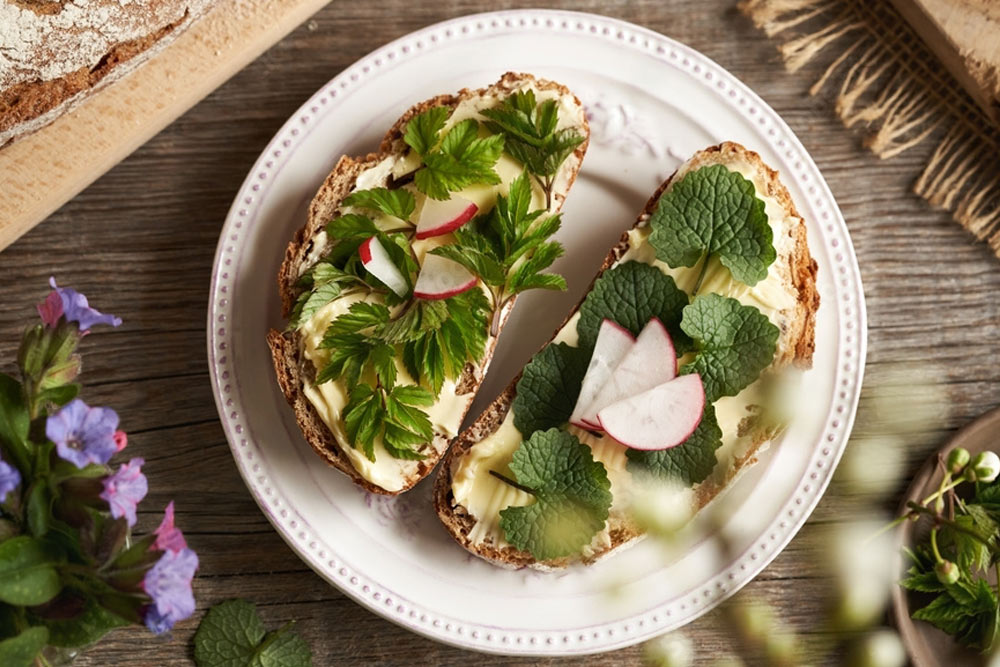
These are just a few starting points. With its subtle garlic flavour and surprising versatility, garlic mustard can be incorporated into various dishes, adding a unique twist to your meals. Don’t be afraid to experiment and discover your own culinary creations!
A Look Back: Traditional Uses of Garlic Mustard
While the ecological impact of garlic mustard requires ongoing management, it has a long history of traditional herbal use. Here’s a glimpse into some potential applications, but remember, scientific evidence to support these claims is limited:
- Respiratory Relief: Garlic mustard tea, prepared by steeping the leaves in hot water, has been used traditionally to soothe coughs and colds. Its potential decongestant properties might help clear congestion and ease discomfort.
- Digestive Aid: The presence of bitters in garlic mustard may help stimulate digestive juices and ease occasional digestive discomfort.
- Skin Soothing: Poultices made from crushed garlic mustard leaves have been used traditionally to soothe minor skin irritations.
Disclaimer: It’s important to remember that these are traditional uses, and more research is needed to confirm the effectiveness of garlic mustard for any specific health condition. Always consult a healthcare professional before using garlic mustard medicinally.
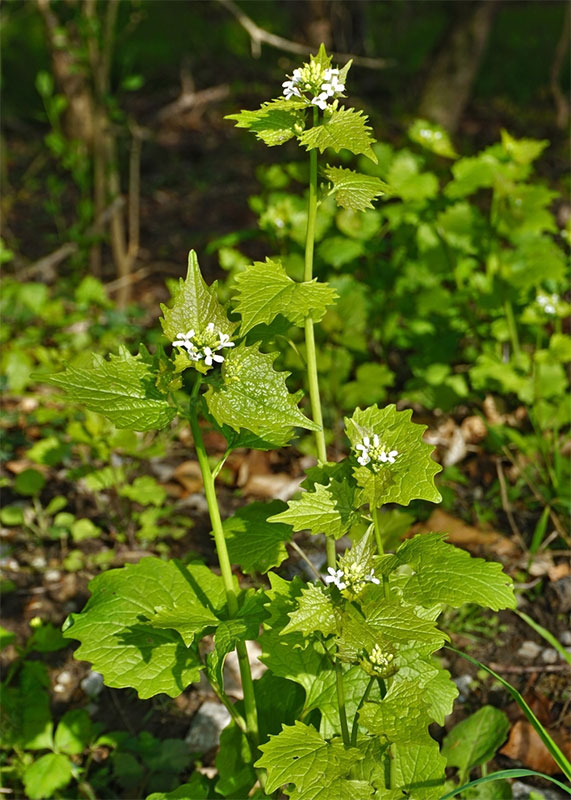
Garlic Mustard – A Flavorful Spring Discovery
Garlic mustard might be a common sight on the trails, but it offers more than meets the eye. With its versatility in the kitchen and potential for traditional uses, this wildflower plant holds surprising potential. Remember to harvest responsibly, focusing on young plants, and enjoy the unique flavours garlic mustard has to offer! By incorporating this unexpected ingredient into your meals, you can embark on a culinary adventure while appreciating the resourcefulness of nature.
Unfortunately, there isn’t a definitive scientific analysis readily available for the exact nutritional content of garlic mustard. However, based on historical uses and some preliminary studies, garlic mustard is believed to contain several potentially beneficial nutrients:
Vitamins:
- Vitamin A: Crucial for healthy vision and a strong immune system, Vitamin A plays a vital role in maintaining healthy skin and mucous membranes.
- Vitamin C: A powerful antioxidant, Vitamin C helps protect your cells from damage and supports overall health.
Minerals:
- Iron: Essential for transporting oxygen throughout the body, iron deficiency can lead to fatigue and weakness. Garlic mustard provides a potential plant-based source of this vital mineral.
- Calcium: Important for strong bones and teeth, calcium also plays a role in muscle function and nerve transmission.
- Potassium: Helping regulate blood pressure and muscle function, potassium is an important electrolyte for overall health.
Other Potential Benefits:
- Garlic mustard is a good source of dietary fibre, which can aid digestion and promote feelings of fullness.
- It may contain beneficial plant compounds with antioxidant and anti-inflammatory properties.
Important Note: This information is based on limited research and traditional uses. It’s important to remember that the exact nutritional content of garlic mustard might vary depending on factors like soil conditions and the specific variety.
Here are some additional points to consider:
- While garlic mustard might offer some potential health benefits, it’s best to consume it in moderation, especially if you are pregnant, breastfeeding, or taking any medications.
- Always consult a herbalist professional before using garlic mustard medicinally.
Foraging for garlic mustard can be a fun and rewarding experience, but proper identification and responsible harvesting are crucial. Enjoy exploring the world of wild Irish plant edibles!


